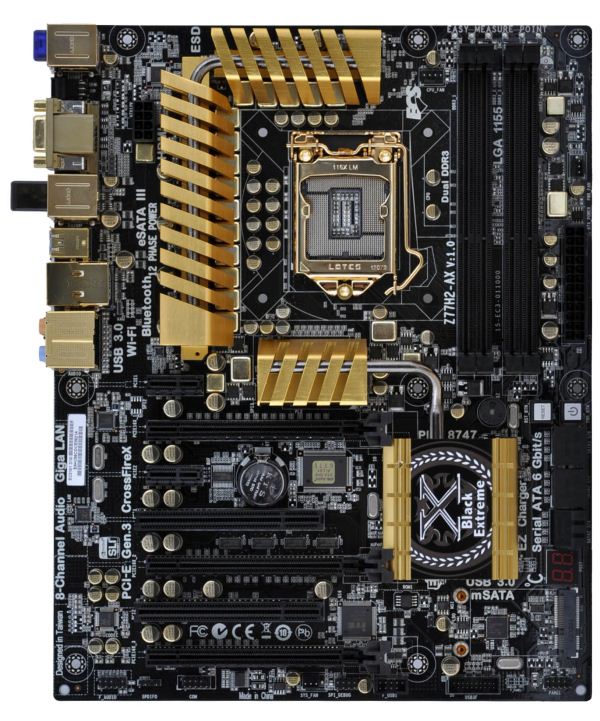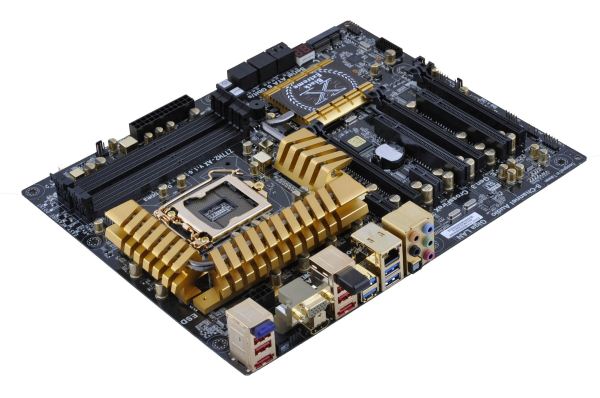Intel Z77 Panther Point Chipset and Motherboard Preview – ASRock, ASUS, Gigabyte, MSI, ECS and Biostar
by Ian Cutress on April 8, 2012 12:00 AM EST- Posted in
- Motherboards
- Intel
- Biostar
- MSI
- Gigabyte
- ASRock
- Asus
- Ivy Bridge
- ECS
- Z77
ECS Z77H2-AX—Visual Inspection
If all you ever wanted in life was something colored gold, I think ECS have you covered. As part of their Golden Board branding, the ECS Z77H2-AX has been plated with a layer of gold paint. Well, their heatsinks, heatpipes, socket, capacitors, VRMs and IO panel have all had a layer of gold paint added in order to improve aesthetics. When I first took this board out of the wrapper, I was figuratively blinded by just how much of the gold color was in my face.
Initially ECS will be releasing two high-end Z77 boards, with this one being the most expensive we have in for review, at an MSRP of $319. As such, I would expect it to perform near the top in almost every aspect—features, extras, performance and usability. As more than twice the price of the ASRock Z77 Extreme4, it had better be at least twice the board.
For a start, we can see that the socket is closed in, with the heatsinks and the memory slots being right up against Intel's minimum required socket spacing. This means big air coolers may not get a chance to fit, and only stock or water-cooling need apply. If that is the case, then I hope ECS have a robust overclock system in place.
One thing to feel disappointed by the ECS board though is the lack of fan headers. Around the socket you are lucky to have two—one 4-pin between the top VRM heatsink and the memory slots, and a 3-pin just above the 24-pin ATX power connector. A solitary third is on the bottom of the board. In the past ECS fan OS controls have had some of the better software support; however, it does not make sense to have only three headers on this.
Down the right hand side of the board, below the ATX power connector, are a pair of power/reset buttons, the standard six SATA ports from the PCH, and a two-digit debug display. Note we do not have any other SATA controllers for internal ports on the board. Below the two-digit debug display is an mSATA connector, which doubles up as a mini-PCIe if a user want to use a WiFi module (note, there is one on board already) or a TV Tuner.
On the south side of the board we are not given a vast amount of headers to say it is cramped—aside from standard front panel headers, there is a USB 3.0 header, a COM header, and a solitary USB 2.0 header.
This big selling point of this board over the other boards in this preview however is its multi-GPU capabilities. ECS have decided to invest in a PLX PXE 8747 chip, which is akin to the NF200 chips we saw on X58. This chip will expand the 16 PCIe 3.0 lanes on the board to 32, meaning that on the PCIe slots, we can have x16/x16 in dual card mode, or x16/x8/x8 in tri-card mode.
Thus in order we have an x1, an x16, x1, PCI, x16/x8, PCI, x8. So if all three full length PCIe slots are filled, there is still access to an x1 and a PCI, but we lose a lot of the functionality on the south part of the board.
The back panel has a mix and match of capabilities and functionality. From the left, we have a Bluetooth dongle, two USB 2.0 (red), an eSATA, a clear CMOS button, D-Sub, HDMI, a WiFi dongle, two USB 2.0, an eSATA, two USB 3.0, gigabit Ethernet, two USB 3.0, optical SPDIF and audio jacks. The big selling point for me is the WiFi, which ECS have cunningly added to their top range boards for a few chipsets now.
Board Features
| ECS Z77H2-AX | |
| Size | ATX |
| CPU Interface | LGA-1155 |
| Chipset | Intel Z77 |
| Power Delivery | 12 + 2 |
| Memory Slots |
Four DDR3 DIMM slots supporting up to 32 GB Up to Dual Channel, 1066-2800 MHz |
| Video Outputs | HDMI, D-Sub |
| Onboard LAN | Realtek 8111E |
| Onboard Audio | Realtek ALC892 |
| Expansion Slots |
2 x PCIe x16 Gen3 (x16, x8/8) 1 x PCIe x16 Gen2 (x4) 2 x PCIe x1 Gen2 2 x PCI |
| Onboard SATA/RAID |
2 x SATA 6 Gbps (PCH), Support for RAID 0, 1, 5, 10 4 x SATA 3 Gbps (PCH), Support for RAID 0, 1, 5, 10 2 x eSATA 3 Gbps |
| USB |
6 USB 3.0 ports (4 back panel, 2 from headers) 6 USB 2.0 ports (4 back panel, 2 from headers) |
| Onboard |
2 x SATA 6 Gbps 4 x SATA 3 Gbps 1 x USB 3.0 Header 1 x USB 2.0 Header 3 x Fan Headers 1 x COM Header 1 x SPDIF Output Header 1 x Front Panel Audio Header Power/Reset Buttons Debug LED 1 x mSATA |
| Power Connectors |
1 x 24-pin ATX connector 1 x 8-pin 12V connector |
| Fan Headers |
1 x CPU Fan Header (4-pin) 1 x SYS Fan Header (3-pin) 1 x PWR Fan Header (3-pin) |
| IO Panel |
4 x USB 3.0 Ports 4 x USB 2.0 Ports 1 x HDMI 1 x D-Sub 1 x Gigabit Ethernet 1 x Optical SPDIF Output 1 x Clear CMOS Button 1 x Wifi Connector 1 x Bluetooth 2 x eSATA 3 Gbps Audio Ports |
| Warranty Period | 3 Years from date of Purchase (3yr parts, 2yr labor) |
| Product Page | Link |
Despite having WiFi, mSATA and extended PCIe 3.0 lanes, the ECS board is down on audio (Realtek ALC892 rather than ALC898 of others), lacking fan headers and also lacking video outputs, with a lot of people requiring DVI to D-Sub or DVI to HDMI connectors.













145 Comments
View All Comments
t4murphy - Wednesday, April 18, 2012 - link
That was a good cpu for me before I went to the 920. I still ran MS FS9 with good results along with my GTX 8800. Im not laughing:)rocknrob - Thursday, April 12, 2012 - link
I had a 920 X58 setup and decided to rebuild to an i7 2700K Z68. So far I've regretted the whole thing. I'm going to pick up one of these ASUS Z77 Deluxe boards but I don't think it's going to make a big difference.The X58's/i7's were rock solid and performance monsters. I honestly see very little in terms of performance gains. Supposedly Ive Bridge processors are only going to give you about 15% to 20% increase in performance. If that's the case I think I'm going to stick with the 2700K until the next architecture change.
457R4LDR34DKN07 - Sunday, April 8, 2012 - link
you need to get a asus P8Z77-I DELUXE review.Mitxplease - Sunday, April 8, 2012 - link
Hells yes.GreenEnergy - Sunday, April 8, 2012 - link
I only found one (tiny) review sofar:http://vr-zone.com/articles/first-look-asus-p8z77-...
457R4LDR34DKN07 - Wednesday, April 11, 2012 - link
I actually would like a comparison with ZOTAC Z77-ITX WiFi, as I'm leaning toward the zotac mobo due to the msata compatibility by removing the wifi/bt module.ViperV990 - Sunday, April 8, 2012 - link
Does the Virtu MVP stuff work with an Eyefinity or NV Surround setup?martinw89 - Sunday, April 8, 2012 - link
I'm very curious about this too. On page two, Ian says "Within the hybrid system, the integrated GPU takes over two of the tasks for the GPU – snooping for required frames, and display output. This requires a system to run in i-Mode, where the display is connected to the integrated GPU."But on page 3, Lucid's own slide makes it sound like these new features are monitor configuration independent: http://images.anandtech.com/doci/5728/Lucid1.png
This is a super interesting feature, and I hope it performs as well in reality as it sounds like on paper. And with a triple screen setup it would be bliss.
jimnicoloff - Sunday, April 8, 2012 - link
I have a three monitor setup working just fine on a Z68 board with all monitors attached to a 6970. Virtu gives the option of which you want to be primary - the video card or the integrated graphics. So for me (with the video card primary) this works kind of backwards from a power saving point, but good for performance since it still allows for quick sync video transcoding, etc.I know this doesn't adress the new Virtu MVP, but I can't see them taking a step backwards when something similar works on the old version. Especially since if you are running in eyefinity mode it is just seen by the system as one big wide monitor and not three separate screens that each get their own render. Hopefully they can pull it off because I like my three screen setup and would hate to lose features because of that.
Zoomer - Tuesday, April 10, 2012 - link
I'm leading no:"This requires a system to run in <b>i-Mode, where the display is connected to the integrated GPU.</b>"